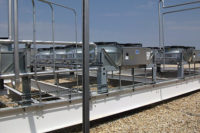Refrigeration Has More 'Legal' Feel

With all the talk about green technology, it was only appropriate that many of the breaks at the FMI Energy & Technical Services Conference took place amidst some green foliage during the Orlando event.
With a new administration in Washington expected to take a higher profile in terms of environmental issues, HVACR contractors and supermarket engineers will need to watch and respond to a wide range of pending regulatory issues.
Sheila Millar, partner in the law firm Kellar and Heckman LLP, noted that the so-called “Gang of 10” U.S. Senators have unveiled an $84 billion plan billed as the Energy Reform Act of 2008, with similar legislation under discussion in the House of Representatives. She noted it has three major components:
• Transition vehicles to nonpetroleum-based fuels with an “85 percent transition within 20 years.”
• Federal commitment to conservation and energy efficiency, including “renewable energy, carbon mitigation, and energy conservation and efficiency tax incentives.”
• Targeting of domestic production of energy resources, including “offshore drilling and nuclear energy.”
One aspect, she said, may be an increase in the use of electrical vehicles (EVs). “Grocery stores may be required or may want to provide chargers to fuel (customers’) electric vehicles. EVs can travel about 50 miles on a charge. That’s perfect for local errands,” she said.
LEVELS OF LEGISLATION
Paul Hepperla, director of energy services for Verisae Inc., said legislation and regulations range from international efforts such as the Kyoto Protocol to local initiatives, such as conferences of mayors promoting green initiatives in cities and towns.Bringing efforts in terms of energy-efficient equipment into line with regulations related to green initiatives and sustainability is important, he said, because “your competitors are doing it right now and your customers are interested in what you are doing - and not doing.”
One particular aspect of environmental efforts relates to carbon footprints of buildings. Minimizing that footprint is becoming a high priority.
“The bad news is that it is coming quickly, it’s complicated, and it means more work for you and your team,” Hepperla said. “The good news is that you have most of what you need to do a footprint and you can save money and make money at the same time.”

Paul Hepperla: “You have most of what you need to do a (carbon) footprint (measurement) and you can save money and make money at the same time.”
SUSTAINABILITY
This is an era of sustainability, said Michael Sansolo, president of Sansolo Solutions. For supermarkets, he said, “Sales are OK, but profits are slippery because people are shopping more carefully.”He also noted those consumers are going to drive stores to adapt technologies that reflect a response to climate change. “The issue is how it is being perceived, not whether or not it is a lot of hooey. [And] retailers are leading government in terms of use of solar energy. Those big roofs have room for solar panels.”
Edward Estberg, senior director facilities for supermarket chain Raley’s, described sustainability as a journey.
“It affects all areas of our business,” he noted. For supermarkets, some components that could demonstrate greater sustainability include direct-drive compressors, induction lighting, condensing boilers, and hot water heaters.
TRENDS IN EUROPE AND U.S.
As the United States deals with mounting regulatory efforts, we can look to Europe where the pace of such governmental involvement is moving even faster - and bringing even more dramatic industry responses.Andy Campbell, head of refrigeration environmental for Tesco Stores Ltd., noted that the continued pressure to ban such gases as HFCs is “causing a drive to natural refrigerants. One of the most discussed is R-744 (CO2).” He noted that R-744 has been used in cascade systems, but is beginning to be used more and more in transcritical applications.
Meanwhile, CO2 is gaining a greater foothold in the United States, according to a report from Mark Hankle, a mechanical engineer for Price Chopper Supermarkets. He reported on a cascade system installed at a Price Chopper store in Saratoga, N.Y.
He said the refrigerant was chosen “to meet corporate sustainability initiatives, to reduce our carbon footprint, and reduce copper line sizing and component size.”
The pros include low global warming potential, nonflammable and nontoxicity (“It’s in your soda and beer”), high volumetric refrigerating capacity, and low refrigerant mass flow, he said. The negatives, he said, include higher pressures.
Based on studies at the store, he said, “No single refrigerant is ideal for all applications. CO2 technology is promising in various applications, but there is no general solution for the substitution of HFCs.”
Publication Date: 11/03/2008





